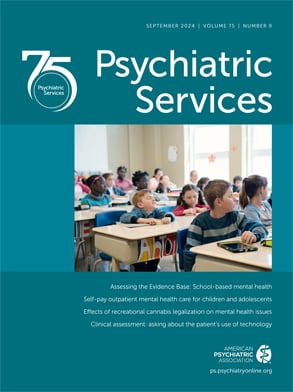Individuals with mental illness and co-occurring addictive disorders account for 44% of the cigarettes sold in the United States ( JAMA 284:2606–2610, 2000). Smokers with mental illness face serious tobacco-related consequences, including increased morbidity and mortality, isolation, stigma, and financial hardship. Tobacco use also increases the metabolism of some antipsychotic and antidepressant medications, with the potential for subtherapeutic treatment and higher rates of rehospitalization.
Nearly half of U.S. state psychiatric hospitals now ban tobacco use on their premises. The American Psychiatric Association identifies psychiatric hospitalizations as an ideal opportunity to treat tobacco dependence. Yet little research has examined tobacco cessation treatments in inpatient psychiatry. If tobacco dependence is left unaddressed, most psychiatric patients return to smoking immediately after discharge ( American Journal of Addictions 15:15–22, 2006). Multicomponent interventions are needed that address the motivational, behavioral, and physiological aspects of nicotine dependence for smokers with co-occurring psychiatric disorders.
We briefly describe an innovative tobacco treatment intervention initiated during psychiatric hospitalization. The intervention combines a computer-delivered expert system intervention and manual based on the transtheoretical model, an individual counseling session, and nicotine replacement therapy (NRT). The model identifies five stages of change: precontemplation (no immediate intention to stop smoking), contemplation (intending to quit in the next six months), preparation (considering quitting in the next month with a quit attempt in the past year), action (quit smoking for less than six months), and maintenance (smoke-free for at least six months).
The 20-minute computer intervention generates individualized feedback at a sixth-grade reading level to guide participants through the stages of quitting smoking and to direct them to relevant sections of the manual. In a 30-minute session with the participant, study counselors review the printed feedback and manual, identify and support goals concerning tobacco use, and discuss proper use of NRT.
Nine hospitalized psychiatric patients representing a range of psychiatric, demographic, and tobacco-use characteristics intensively evaluated the intervention components. Despite having fairly limited computer experience, all agreed or strongly agreed that the program was easy to understand and gave sound advice, and all recommended the computer program to others. Most participants required assistance with program navigation, suggesting the need for more user-friendly capabilities, such as a touch screen and audio. All participants read part of the manual, and most read beyond their stage-of-change chapter. Participants rated the manual highly for its organization and helpful strategies, describing it as "realistic" and "easy to understand … good for any person to read." Participants also rated the counseling session highly, citing the openness of the dialogue, the focus on their needs and interests, and the lack of pressure to quit: "She didn't push any points … she just presented the material. She was open, nonjudgmental…. She let me come to my own conclusions that I want to quit." Most participants used NRT, identified several benefits, and expressed interest in continuing NRT after hospitalization. Side effects also were noted. Of concern, most participants stated that clinical staff did not instruct them in proper use of NRT.
This small and intensive evaluation suggests that the intervention provides a viable and acceptable strategy for initiating tobacco treatment in the inpatient psychiatric setting. In a randomized clinical trial, we are evaluating efficacy of the intervention relative to usual care. With a 79% recruitment rate, we enrolled 224 participants. After the brief hospital stay, intervention participants received ten weeks of NRT and two additional computer contacts, and their outpatient providers were informed of their cessation goals. Follow-up continues for 18 months.
Psychiatric hospitals are making important strides in banning tobacco use. Bans, however, are only part of a much larger strategy needed to overcome the high rates of tobacco use in populations with mental illness. If cessation services are not offered, patients may misperceive smoking bans as punitive and themselves as unworthy of receiving intervention on this deadly addiction. When smoking was allowed on psychiatric units, an average of 15 minutes was spent per nursing shift managing patients' cigarette use. Ideally, a portion of the time saved with a no-smoking policy could be shifted to delivery of cessation services. The findings present an innovative, acceptable, multicomponent intervention for initiating tobacco treatment in inpatient psychiatry.
Acknowledgments and disclosures
This program is funded by grants K23-DA-018691, K05-DA016752, and P50-DA09253 from the National Institute on Drug Abuse. The computerized tobacco cessation program and manual were developed by Pro-Change Behavior Systems, Inc.

